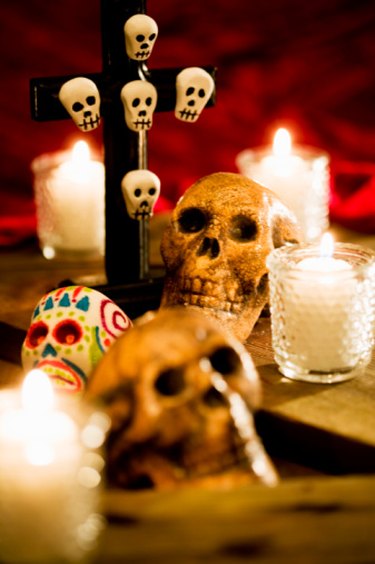
The Day of the Dead, or "El Dia de los Muertos" in Spanish, is a three-day Mexican holiday that lasts from October 31st to November 2nd. In the United States, Mexican families often celebrate the holiday on November 2nd. The Day of the Dead is a time to remember the deceased and welcome spirits home. Instead of being an entirely somber occasion, the holiday is a joyous celebration of life and death. People celebrate by creating altars, tending grave sites and taking part in festivities and parades.
Decorating Motifs
Video of the Day
Skulls and skeletons are central Day of the Dead motifs. In Mexico, bakeries display skull-shaped cookies and cakes in their storefront windows. Street vendors sell an assortment of items, including skeleton jewelry, figurines and marionettes. Local markets and shops offer sugar coffins with skeletons inside them. People can purchase "calacas," wooden or paper toy skeletons. "Calacas" are often humorous in appearance; the toy skeletons may hold guitars or drive cars. Farmers sell orange marigolds, an important autumn flower associated with the Day of the Dead. The ancient Aztecs, whose beliefs about death are preserved in the Day of the Dead, referred to marigolds as the flowers of the dead.
Video of the Day
Celebrations and Parades
Similar to Halloween customs, on October 31st some Mexican children travel around their neighborhoods in costumes and collect candy and fruit from neighbors. Instead of saying "trick or treat," the children say, "calaveras," which is Spanish for "skulls." Some children may carry a coffin with a real boy or girl inside dressed up as a dead person. Passersby toss coins, candy or fruit into the open coffin. On November 2nd in both the United States and Mexico, people celebrate the Day of the Dead by attending parades and festivities that include music, food, and people dressed up in masks and costumes.
Altars
Families who celebrate the Day of the Dead often arrange an altar on a table in their home. On the altar they place "ofrendas" (offerings) of pictures of deceased loved ones along with candles, incense, marigolds and the favorite foods of the deceased. A traditional ofrenda is pan de muertos, a bread baked into the shape of skulls, people or animals. Many Mexicans believe that when children die, they become little angels, "angelitos," and return to visit their families on November 1st. To honor and welcome los angelitos, families arrange on their altars toys and photographs of the deceased children.
Visiting Cemeteries
On November 2nd, families often trek to cemeteries to visit their deceased loved ones. Family members tidy up graves, "las tumbas," by raking, sweeping or weeding around them. Flowers, such as marigolds, are placed on the graves. In the evening, families partake in picnics in the cemetery by spreading out tablecloths of food near graves. They make sure to leave extra food for the souls of the dead. Families light candles around the graves, share stories about deceased loved ones, sing, dance and play music.